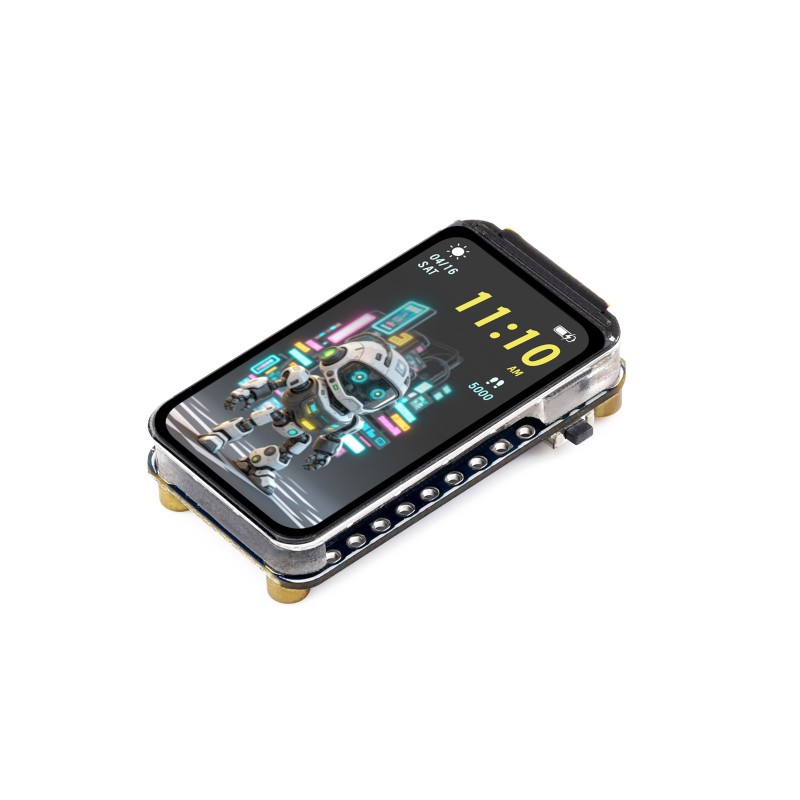






zł37.19 tax excl.
RP2350-LCD-1.47-A is a compact development board featuring the RP2350A microcontroller and a color LCD screen, offering high computing performance and low power consumption. With support for dual CPU architectures and USB programming, it is ideally suited for educational projects, graphical demonstrators, and integration with consumer and portable devices. The version with a USB Type-C port and without pre-soldered headers provides greater flexibility for mounting and adaptation.
A compact development board designed by Waveshare, based on the RP2350A microcontroller with a unique dual-core, dual-architecture design: two Arm Cortex-M33 cores and two Hazard3 RISC-V cores. Clocked up to 150 MHz, the chip offers high performance with low power consumption. The board features a 1.47-inch color LCD display with a resolution of 172×320 pixels and 262 thousand colors, an RGB LED, and a TF card slot. This version comes with a USB Type-C port and without pre-soldered goldpin headers. Supports "drag-and-drop" programming via USB mass storage.
Data sheet
Manufacturer BTC Korporacja sp. z o. o. Lwowska 5 05-120 Legionowo Poland sprzedaz@kamami.pl 22 767 36 20
Responsible person BTC Korporacja sp. z o. o. Lwowska 5 05-120 Legionowo Poland sprzedaz@kamami.pl 22 767 36 20
Base board with soldered Raspberry Pi Pico W module. Equipped with numerous connectors, buzzer, buttons and LEDs. Cytron MAKER-PI-PICO-MINI-W
This modern development board features a dual-core Cortex-M33 microcontroller clocked at 150 MHz, 520 KB of RAM, and 8 MB of QSPI Flash. It features a rich set of interfaces, including I2C, SPI, UART, 24 PWM channels, and an HSTX port for high-speed differential data transfer. The board features a STEMMA QT connector, a built-in 200 mA+ LiPo charger, a USB-C port with a UF2 bootloader, and NeoPixel LEDs and a red LED for signaling. The Feather RP2350 is compatible with MicroPython, CircuitPython, Arduino, and C/C++. Adafruit 6000
Board with RP2040 microcontroller and W6100 network chip. The module is equipped with an Ethernet interface. WIZnet W6100-EVB-Pico
RP2350B-Plus-W is an advanced development board with an RP2350B microcontroller and wireless Wi-Fi/Bluetooth communication, enabling selection between ARM and RISC-V architectures. Intended for educational applications, IoT device prototyping, and projects requiring versatile communication and processing capabilities.
No product available!
Servo driver based on the Raspberry Pi RP2040 microcontroller. It allows you to control up to 18 servos, has 6 analog inputs and a QW/ST connector for connecting additional sensors. Pimoroni PIM613
Module with a round 0.99" IPS LCD display with a resolution of 128x115 px and an RP2040 microcontroller. Equipped with an accelerometer and gyroscope. Enclosed in a nice metal housing. Waveshare RP2040-LCD-0.99-B
Mini board with the RP2040 microcontroller equipped with two ARM Cortex-M0 + cores, which work at a frequency of 133 MHz and 264 kB RAM. The board also has 8 MB of QSPI flash memory. The system can be programmed in C/C++ or MicroPython. Pimoroni PIM558
RP2350-Touch-LCD-2 is a compact and cost-effective development board featuring an IPS touchscreen display, motion sensor, and camera interface. Designed for developing interactive, educational, and portable applications, it is based on the RP2350 microcontroller with a unique ARM + RISC-V architecture.
Base board with soldered Raspberry Pi Pico module. Equipped with numerous connectors, buzzer, buttons and LEDs. Cytron MAKER-PI-PICO-MINI
Development board with RP2040 microcontroller. Equipped with a driver for DC motors, servos and Grove connectors. Dedicated to the construction of robots. Cytron MAKER-PI-RP2040
Pimoroni Pico LiPo 2 XL W PIM776 is an extended development board with the RP2350B, offering Wi-Fi and Bluetooth connectivity, 16 MB of flash memory and 8 MB of PSRAM. Thanks to its 40 GPIO pins, integrated LiPo charging system and numerous interfaces, it works well in advanced IoT projects and battery-powered systems.
A compact and powerful development board featuring the RP2350B microcontroller, featuring a dual-core ARM Cortex-M33 processor and Hazard3 RISC-V processor. It features 520 KB of SRAM, 16 MB of Flash, expandable with PSRAM, a DVI connector, a PIO-USB port, a microSD slot, and a 40-pin GPIO header. The board supports SPI, I2C, UART, and USB communication, and offers 12 programmable state machines (PIOs) and an on-board temperature sensor. Waveshare RP2350-PiZero
No product available!
Board with RP2040 microcontroller and class D mono audio amplifier based on MAX98357 chip. It has a built-in LIS3DH three-axis accelerometer, an RGB NeoPixel LED, a LiPo charging circuit, and a STEMMA QT connector. Adafruit 5768
An enhanced version of the Raspberry Pi Pico 2 with access to all 48 GPIO pins and an RP2350B microcontroller (Cortex-M33 or RISC-V) clocked at up to 150 MHz. It offers 16 MB of Flash, 8 MB of RAM, and a microSD card reader, making it ideal for complex embedded and IoT projects. With USB-C, Qwiic/Stemma Qt, UEXT connectors, and BOOT/RESET buttons, it offers high flexibility and easy integration with peripherals. Olimex RP2350-PICO2-XXL
RP2350-GEEK is an advanced diagnostic and development platform for electronics designers. It enables convenient debugging of ARM microcontrollers, testing of I2C and UART peripherals, and data visualization on a color display. Thanks to its compact enclosure and set of interfaces, it is an excellent tool for learning, prototyping, and embedded project development.
Module with a round 1.28" IPS LCD display with a resolution of 240x240 px and an RP2040 microcontroller. Equipped with an accelerometer and gyroscope. Enclosed in a nice metal housing. Waveshare RP2040-LCD-1.28-B

RP2350-LCD-1.47-A is a compact development board featuring the RP2350A microcontroller and a color LCD screen, offering high computing performance and low power consumption. With support for dual CPU architectures and USB programming, it is ideally suited for educational projects, graphical demonstrators, and integration with consumer and portable devices. The version with a USB Type-C port and without pre-soldered headers provides greater flexibility for mounting and adaptation.
